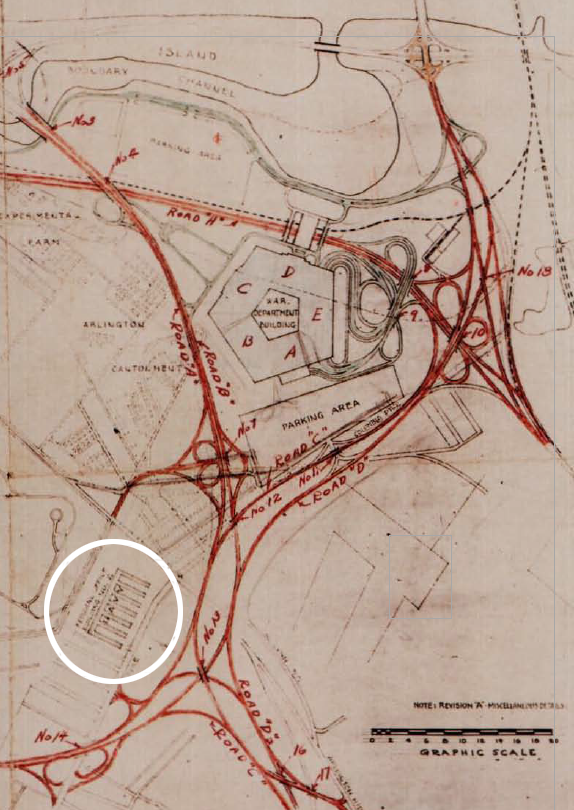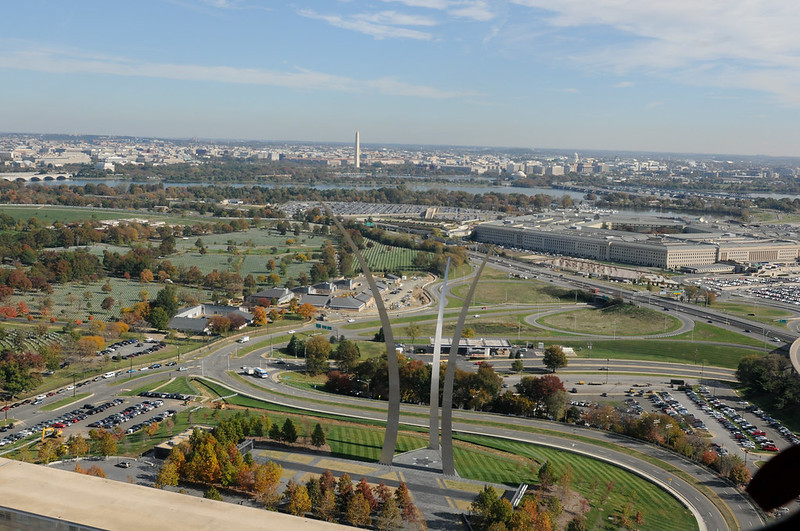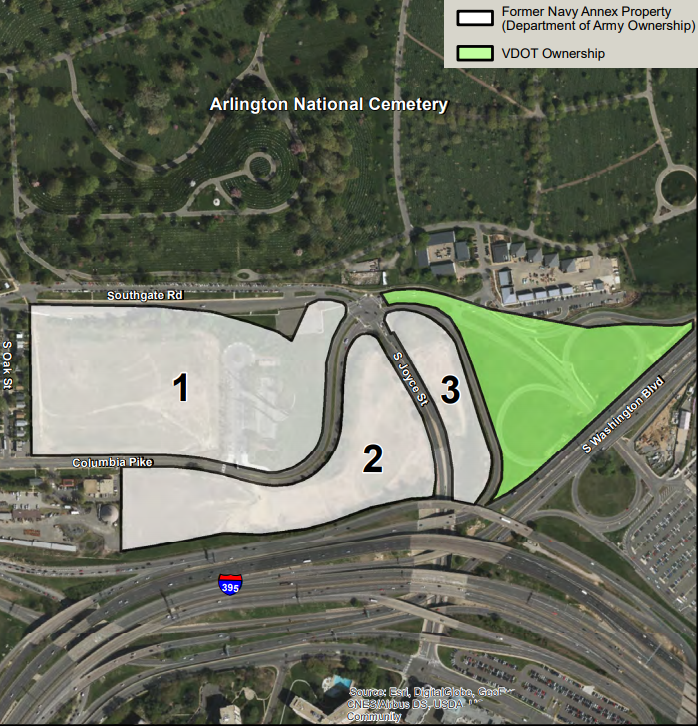
the Navy Annex and the Pentagon shared the same upgraded road network (red lines)
Source: Office of the Secretary of Defense, The Pentagon: The First Fifty Years (p.65)

the Navy Annex and the Pentagon shared the same upgraded road network (red lines)
Source: Office of the Secretary of Defense, The Pentagon: The First Fifty Years (p.65)
In 1941, President Franklin D. Roosevelt's administration planned to expand military forces in response to war in Europe and threats from Japan. Headquarters offices in the District of Columbia would need more space to accommodate more people.
The US Army planned a new headquarters building, what became the Pentagon. The US Navy planned to make space within its headquarters on the National Mall, by building a new warehouse in Arlington County and moving archived records there. A million-square-foot building was designed with eight wings, for a 42-acre parcel on the hillside east of the Arlington House mansion.
Then the plans were revised to use the new building to house people. The Marine Corps headquarters moved in on November 8, 1941. For the next four years, the Marine forces engaged in the Pacific theater were commanded from the building known as the Navy Annex. The Secretary of the Navy stayed on Constitution Avenue, but the Secretary of War moved to the Pentagon in 1942.
When the US Navy was forced to move its headquarters to the Pentagon and the Department of Defense consolidated the services, the Marine Corps maintained its separate command center in the Navy Annex until 1966.1
New roads were built to serve both the Navy Annex and the Pentagon, and they shared the boiler plant and sewage treatment plant.2
The Navy Annex was technically Federal Office Building (FOB) 2. Seven of the eight four-story wings survived until 2013. The eighth wing was removed in 2004; the Air Force Memorial needed the space. The Navy Annex stayed a utilitarian structure. Creature comforts were so minimal that staff assigned to the building felt they were valued less than staff assigned to offices in Rosslyn or Crystal City. Technology upgrades provided infrastructure for computers and communications, but:3
In 1966, the office of the Commandant of the Marine Corps was finally moved to the Pentagon.
In 2004, the eighth wing of the four-story Naval Annex building was demolished to create space for the Air Force Memorial. That memorial was originally planned for a site on Arlington Ridge near the Iwo Jima memorial, after considering 18 alternatives. The National Capital Memorial Commission and the US Commission of Fine Arts approved the location, but veterans of the Marine Corps objected.
The US Congress authorized transfer of three acres of the Navy Annex site to the Air Force Memorial Foundation, providing an alternative location with no interservice rivalry conflicts:4
The original design for the memorial had to be revised; the new site on a promontory was not appropriate for just a large, inverted five-point star. After another design competition, a new design was chosen. It included three soaring, arched spires stretching 270 feet into the sky, inspired by the bomb-burst maneuver of the Air Force Thunderbirds.5

the site of the Air Force Memorial was moved from Arlington Ridge, after the US Congress authorized use of three acres of the Navy Annex
Source: Arlington County, Aerial
The remaining seven wings were removed in 2012. Before the interiors were demolished and the exterior walls finally removed, the empty building was used for training exercises for police, Secret Service and Federal Bureau of Investigation agents, Special Weapons and Tactics (SWAT) teams and other public safety forces.6

the cornerstone of the Navy Annex was removed and total demolition begun in 2012
Source: Defense Visual Information Distribution Service, Demolition begins on Navy Annex
The removal of the Navy Annex was precipitated by a desire to expand the acreage of Arlington Cemetery, to provide 38 more acres for up to 60,000 new graves and a columbarium. It followed a 27-acre expansion in the northwest corner of the cemetery in 2013 known as the Millennium Project, but that space was expected to be filled within 20 years. The alternative to expansion was to tighten eligibility requirements for burial at Arlington.
The decision process to re-purpose the Navy Annex site ended up being complicated. The US Army proposed:7
Arlington County sought to arrange a land swap, hoping to use property for a maintenance garage for the proposed Columbia Pike streetcar or buses. Negotiations continued for years, even after the county cancelled the streetcar project.
The Army decided it wanted full control over the expansion of Arlington National Cemetery, rather than let Arlington County crate a museum or park that might later evolve into a different use. Using authority obtained from the US Congress, the US Army condemned five acres owned by the county and seven acres owned by the Virginia Department of Transportation in 2020.8

Arlington National Cemetery planned to acquire all of the Navy Annex plus state-owned property on Columbia Pike
Source: United States Department of the Army, Final Environmental Assessment - Arlington National Cemetery Southern Expansion and Associated Roadway Realignment (Figure 1-3)